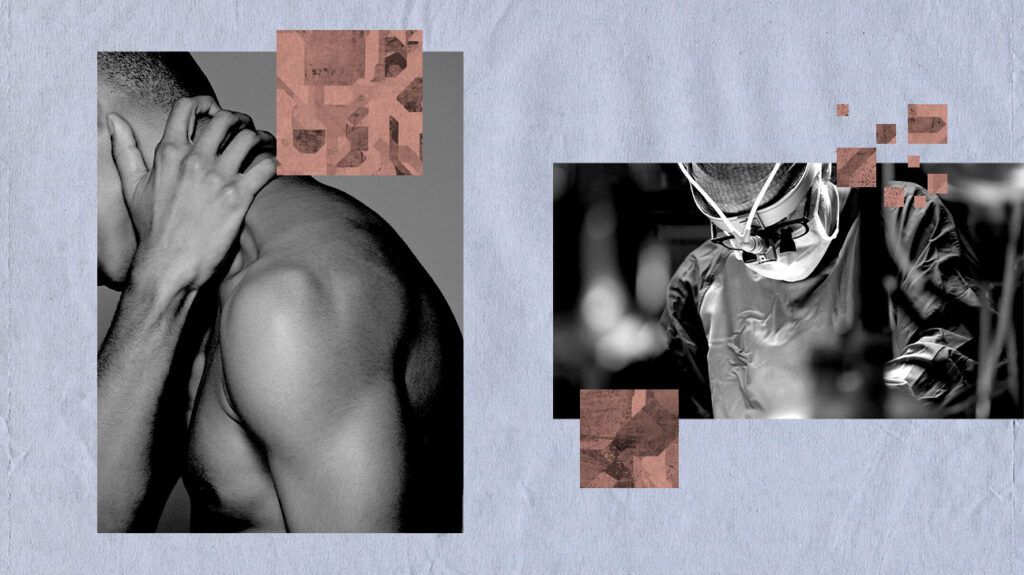The shoulder is a mobile and complex joint that is prone to dislocation and injury. Several types of shoulder surgery can address and correct various shoulder symptoms.
Surgery can repair several structures within the shoulder, including the bones, joints, and tendons. The most invasive shoulder surgeries are open surgeries, where surgeons make incisions and use sutures. The least invasive is arthroscopic, where surgeons insert instruments and an arthroscope, or camera, through small keyholes in the shoulder.
Read on to learn more about the common types of shoulder surgery.

When a person has torn a tendon in their shoulder, rotator cuff repair surgery aims to reattach the tendon to the bone. The rotator cuff is a group of muscles and tendons that hold the arm in the shoulder joint. A tear to this tendon can occur from overuse, injury, or a degenerative condition.
The three types of rotator cuff surgery include:
- Open repair: This is an invasive surgery where the surgeon makes an incision to move the deltoid, a large shoulder muscle, to reach the tear.
- Arthroscopic repair: This technique is known as keyhole surgery, which is less invasive because a surgeon uses a camera or arthroscope to guide the repair. They insert thin tools into the shoulder through small keyholes.
- Mini-open repair: This often involves a surgeon removing bone spurs and repairing any outstanding shoulder damage, typically with an arthroscope.
Several conditions can damage the shoulder to the point someone may need a replacement. They include:
Shoulder replacements are prosthetics, meaning they are artificial replacements of the humerus bone head and socket. Depending on the extent of damage, a person
Before a person undergoes shoulder replacement surgery, a surgeon will take the time to:
- review their medical history
- conduct a physical examination
- review imaging, from X-rays, MRIs, and CT scans
Because shoulder replacement surgery is highly technical and invasive, a person must understand why it is necessary and what the risks are.
A shoulder dislocation occurs when the upper arm is either partly or fully out of the shoulder socket — loose or torn ligaments are the main causes. In cases of chronic shoulder instability, the shoulder can dislocate frequently.
When a person undergoes shoulder surgery for dislocation, the
The types of surgery include arthroscopy and open surgery. In both instances, a person will have their arm in a sling as the shoulder heals and later engage in rehabilitative exercises.
A SLAP tear happens when the labrum — a ring of cartilage surrounding the socket joint, sustains damage. This can happen for several reasons, including:
- vehicle collisions
- falling onto an outstretched arm
- forcefully pulling an outstretched arm backward
- shoulder dislocation
Typically, a surgeon repairs the tear through arthroscopy. Depending on the type of tear, they will either reattach it or remove the damaged tissue.
In
The AC joint is the location where the clavicle, or collarbone, meets the shoulder blade. When the AC joint separates, the ligaments underneath the clavicle tear. Consequently, the collarbone is no longer attached to the shoulder blade, and a person has shoulder separation.
Surgery to shave down the collarbone can help alleviate pain when it is rubbing against the shoulder blade. If the injury is severe, a surgeon may reconstruct the ligaments and reattach them to the underside of the collarbone. Usually, they use arthroscopy to achieve this.
However, doctors typically treat shoulder separation with cold packs and pain management.
Symptoms of shoulder impingement, such as pain and irritation, occur when the acromion rubs against the tendon and bursa. The acromion is the tip of the shoulder blade that meets the collarbone. The bursa is a small fluid-filled sac that reduces friction between bones and tendons.
Usually, shoulder impingement occurs due to overuse of the shoulder. For this reason, it is common in athletes and people who frequently lift objects over their heads, for example, when stacking shelves.
To reduce pain and irritation, a surgeon needs to create space within the shoulder to reduce rubbing and friction. Typically, they use arthroscopy to remove some of the inflamed bursa or part of the acromion.
Doctors do not fully understand what causes frozen shoulder. However, it is more common in people with diabetes and other conditions, including hypothyroidism and Parkinson’s disease.
Symptoms of a frozen shoulder include a dull ache that gradually becomes more severe, especially when a person moves their arm.
If rehabilitative therapy and anti-inflammatories do not ease symptoms, a surgeon may need to manipulate the shoulder to release adhesions. They may also use arthroscopy to cut through the tighter and thicker areas of the shoulder capsule.
During manipulation, a person is under general anesthetic. A surgeon ranges the shoulder, which tears or stretches the scar tissue and shoulder capsule. This instantly increases the shoulder’s range of motion.
There are common types of shoulder surgery that range from rotator cuff repair to full shoulder replacements. Because the shoulder is
Generally, most surgeries involve arthroscopy as it is a less invasive procedure. However, for more complex issues, open surgery is sometimes necessary. In addition to surgery, people often need rehabilitation exercises to heal and strengthen the shoulder.
